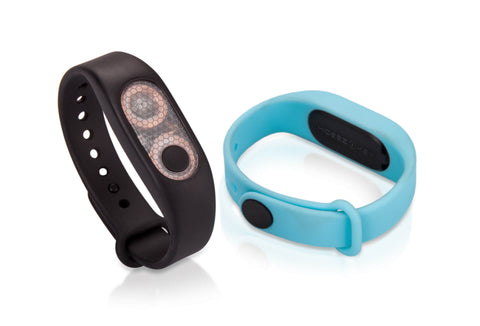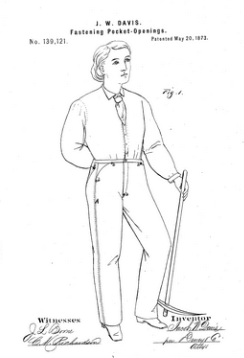
Several hundred thousand years ago, early humans learned to carry sticks around to protect itself and its family from predators and rivals. Later, they learned to carry it around by tying it to their bodies, leaving their hands free and leaving it always ready to be used when needed.
That was perhaps the first wearable security device in human history. Since then, humans, security threats and countermeasures have been evolving.
 The first wearable device in the history of mankind. Image by Max Pixel.
The first wearable device in the history of mankind. Image by Max Pixel.
Wearables today come in many forms, and most have a strong element of utility in everyday life, including for security purposes. Let's take a closer look at the history of wearable devices like pocket watches, wristwatches, eyeglasses, keyfobs, pendants and belt tools, and how they shaped the development of the Hideez Key.
The Evolution of Wearables
Among the first, most widely used wearable was the pocket watch, which was invented in the Middle Ages. Before that, portable watches were essentially cylinders that were carried around by hand or on a chain around the neck. One of the most famous was called the Nürnberger Ei or "Nuremberg eggs" manufactured by clockmaker Peter Henlein, who was based in Nuremberg, Germany.
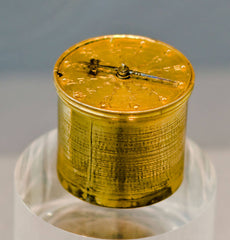 A Nuremberg egg allegedly created by Peter Henlein circa 1550 although his authorship of this exact device remains a matter of scientific dispute. At that time, China was an agricultural country ruled by Emperor Jiajing and each clock was personally manufactured by Henlein and his apprentices in Nuremberg, making these devices limited in number and very expensive. Courtesy of Germanisches Nationalmuseum, Nuremberg. Photo by Wikipedia user Pirkheimer.
A Nuremberg egg allegedly created by Peter Henlein circa 1550 although his authorship of this exact device remains a matter of scientific dispute. At that time, China was an agricultural country ruled by Emperor Jiajing and each clock was personally manufactured by Henlein and his apprentices in Nuremberg, making these devices limited in number and very expensive. Courtesy of Germanisches Nationalmuseum, Nuremberg. Photo by Wikipedia user Pirkheimer.
Originally, the primary customers were monks at monasteries that needed to ring the bells in the bell towers at just the right moment. After monasteries, pocket watches arrived in the courts of European monarchs. Lay people oriented themselves to the bells of the bell towers or stationary clocks at the city administration buildings.
The watches were placed in the pocket for practical reasons. The mechanisms of ancient pocket watches were fragile and prone to rotting from exposure to the elements. In the early XVII century, a glass cover was introduced to protect watch faces from moisture and dust. In the early XIX century, Prince Albert, the husband of Queen Victoria, introduced the “Albert chain”, designed to secure the pocket watch to the jacket using a clip.
Hunter Case
Victorian England also gave rise to hunter-case watches. This type of pocket watch had a metal lid on top of the watch face. The Demi-hunter also had a metal lid. However, it had a circle hole in the center, exposing the hands so that the viewer could quickly guess the approximate time without actually opening the lid.
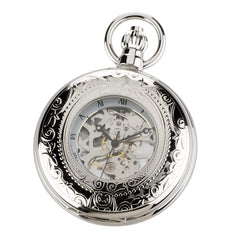 Pocket watch with half hunter case also known as ‘demi savonnette’, because of the case resemblance of a soap bar, ‘savon’ meaning ‘soap’ in French. Image by The Getty Conservation Institute.<
Pocket watch with half hunter case also known as ‘demi savonnette’, because of the case resemblance of a soap bar, ‘savon’ meaning ‘soap’ in French. Image by The Getty Conservation Institute.<
A Present to Napoleon’s Sister
The Wristwatch. The first wristwatches appeared among European aristocracy in the XVI century and initially were a jewelry item worn only by ladies. Constructively, they were pocket watches on a strap or lace usually decorated with precious stones and metals.
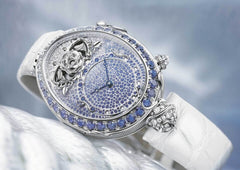
However, in the XIX century, the evolution of artillery and steam engines brought the need for a more practical type of wristwatch. They were needed by officers to coordinate the timing of attacks so that troops were not affected by friendly artillery fire, while offering minimal distractions for officers in combat.
The first solution to the problem was a ‘trench watch’. It was a combination of a pocket watch, and what would later become the wristwatch. Usually, trench watches had a double case to protect the clock mechanism and a mounting lug to which the leather strap was attached. Officers could carry their trench watch both in their pocket and on their wrist. Interestingly, Swiss watchmaker Girard-Perregaux started making such watches for the German Navy in 1880.
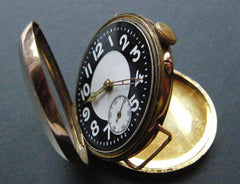 A photo by Wikipedia User Sergei Gutnikov displaying a trench watch from his personal collection.
A photo by Wikipedia User Sergei Gutnikov displaying a trench watch from his personal collection.
Boer Wars and Kickstarter
Right around the same time, in the late XIX century, Britain was waging colonial wars all across the globe. In 1893, the Garstin Company of London patented a “watch wristlet” design. In 1898, Mappin & Webb launched its iconic “Campaign Watch” wristlet model. All these products were based on the success of their military versions in the First Boer War for South Africa and British's successful Burma and Sudan campaigns. The additional cases slowly disappeared. However, most models featured luminous dials made of radium.
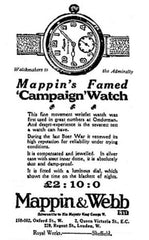
In the 1950s, watches with electronic mechanisms were introduced, then the clock face became digital in the 1960s. Jumping ahead to the next major milestone takes us to 2012 when Pebble raised $10.3 million through a Kickstarter campaign to produce the first commercial smartwatch, a computer on your wrist. However, the form factor of the wristwatch has generally remained the same since the XIX century, as it is the most practical and convenient.
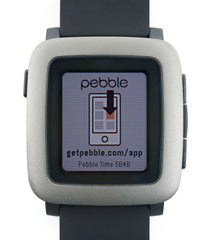
What Do Viking Swords and Ōdachi Have in Common?
Humans invented the sword sometime in 1700-1500 BC. Notably, swords were pretty heavy to carry around, so the scabbard appeared. With the scabbard, a warrior quickly fixed the sword to their waist. However, they had the ability to draw their weapon fast, should it become necessary. The scabbard also served as a case for the sword, protecting its sharpness. It required no unlacing of straps such as those that commonly affixed a sword to the belt.
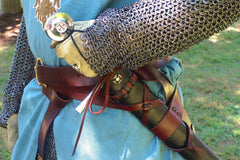
The Japanese ōdachi was a notable exception. This type of a sword was too long to be carried on the waist, so samurais usually carried it on their backs with a special scabbard.

Gold Rush and Jeans
Time passed, firearms and artillery made swords and scabbards irrelevant in the battlefield. However, in 1848 gold was discovered in the Sierra Nevada Mountains. The resulting gold rush lasted for a decade and brought hundreds of thousands of prospectors to California. After the rush was over, many of those people started looking for ordinary jobs as carpenters, builders and other laborers.
Among them was Jacob W. Davis, a tailor who was born in Latvia. A client asked Davis to create durable pants for her husband, who worked as a woodcutter. Davis used denim cotton and copper rivets. The pants were a hit, especially with railroad workers. After some time, Davis entered into a partnership with Levi Strauss. Levi was an immigrant from Austria who had already become rich selling various dry goods during the gold rush. The outcome of the partnership was the invention of jeans.
Jeans revolutionized the waist as a place suitable to carry wearables. Being durable, they allowed space for keeping various tools: from axes or hammers to pencils or gauge tapes. It meant the tools were always at a handy distance. Even better, it didn't cause damage to the fabric of the pants.
Beyond Jeans: The Walkman Generation
By the end of the 1970s, the miniaturization of electronics brought the first electronic devices close to the human body. Of course, the primary place for them was the belt — a symbol of that generation. Among the first to arrive were portable radios and cassette players. In 1979, Sony launched the iconic Walkman.
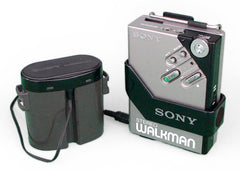
Sony used an old but good concept: unlike competing products, the device itself had no ugly clips attached. Instead, its belt clip was attached to the holder. It became easy to take the device out, change the cassette and then return the player back to the holder. The holder also protected the player from outside impacts.
Sources of Inspiration for Hideez Key 3
When creating Hideez Key 3, we started again with a key fob form factor, which has become the de facto standard in the cybersecurity industry since RSA introduced its bestselling SecurID.
While being convenient and easy to market, the key fob form factor has its share of disadvantages too. For example, the Apple Watch brought the security of wearables to the next level with its wrist detection feature. Wrist detection is currently too complicated for a key fob device. The light sensor has to have permanent skin contact to ensure the device is still on its owner’s wrist.
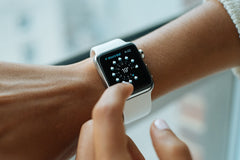
Another drawback of the key fob is that it is traditionally attached to a keychain. There are several potential cases where a person may want to keep their keys in a place away from their PC. It's quite common for some people to place them by the door to their house so they don't forget them - or even inside of a lock so they can open it quickly. By tying the keychain to the keys, it won't always be convenient to use them together. Each time a confirmation from the device or other action is required, the user has to find their keys to execute it.
Taking all these things into consideration, it was decided that Hideez Key 3 should fit in a wristband case. There are already many popular wristband mounted technology hardware devices, including Fitbits, the Xiaomi Mi Band and lots of others.
